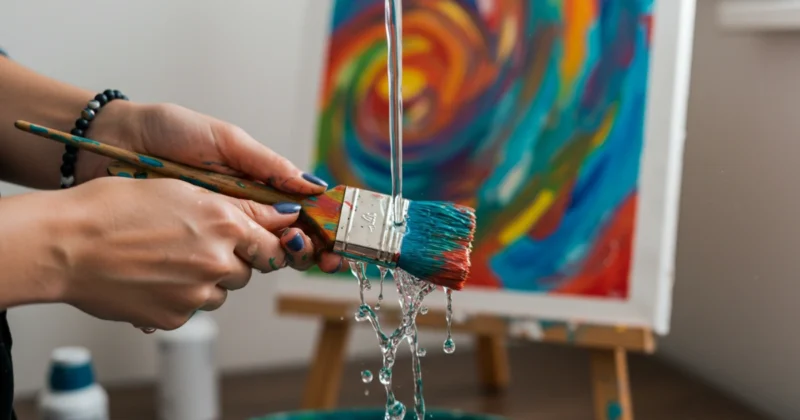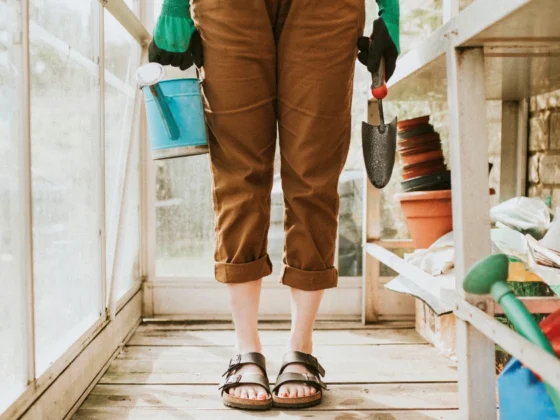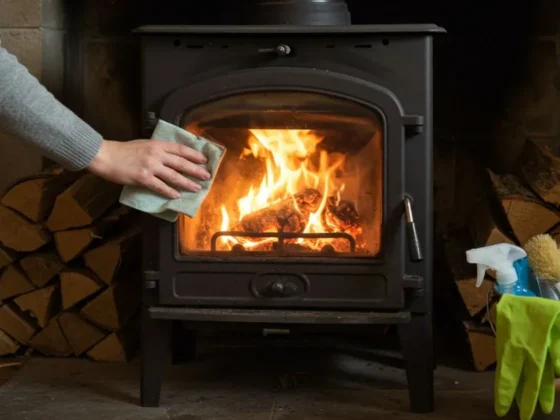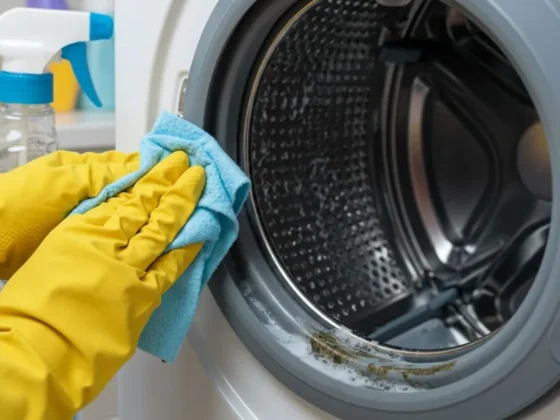Having the right tools is key when painting. Knowing how to clean paint brushes is crucial for their longevity. By following the best cleaning methods, your brushes will stay in good shape. This will save you money and ensure your painting projects are a success.
It’s important to understand the value of cleaning your paint brushes. This way, you can keep them in top condition. This will help you achieve the best results in your painting projects. So, it’s essential to learn how to clean paint brushes effectively.
Why Proper Paint Brush Cleaning Matters
Many of us don’t see the importance of cleaning paint brushes. But, it’s key for top-notch paint jobs. Clean brushes mean smooth, even paint coats.
Proper cleaning paint brushes boosts your paintwork quality. Here’s why:
- Improved paint application: Clean brushes give a smooth finish. Dirty ones cause streaks and unevenness.
- Cost savings: Cleaning your brushes regularly makes them last longer. This saves you money.
- Environmental benefits: Cleaning and disposing of paint and solvents properly reduces waste and pollution.
Impact on Paint Application Quality
Clean brushes are vital for a professional finish. Dirty brushes can ruin your paint job. Regular cleaning paint brushes ensures your paintwork looks great.
Cost Savings Through Brush Maintenance
Keeping your brushes clean extends their life. This saves you money over time. Proper maintenance means you won’t need to replace brushes as often.
Environmental Benefits of Brush Care
Proper cleaning paint brushes and disposing of paint and solvents helps the environment. It reduces waste and pollution, protecting our planet.
What You Need to Clean Your Paint Brushes ?
Cleaning your paint brushes right is key. You’ll need paint brush cleaning tools like mild soap, warm water, and a brush cleaner. Also, a clean cloth or paper towels for drying.
You might also need a brush comb or wire brush for deeper cleaning. It depends on your brush and paint type. Make sure you have these paint brush cleaning tools ready before you start.
Here’s what you’ll need:
- Mild soap
- Warm water
- Brush cleaner or solvent
- Clean cloth or paper towels
- Brush comb or wire brush (optional)
Using the right paint brush cleaning tools ensures your brushes stay in top shape. They’ll be ready for your next painting project.
| Tool/Material | Purpose |
| Mild soap | Cleaning the brush |
| Warm water | Rinsing the brush |
| Brush cleaner or solvent | Removing paint from the brush |
| Clean cloth or paper towels | Drying the brush |
Different Types of Paint and How to Clean Them
Working with various paints means knowing how to clean them. Each paint type has its own cleaning needs. It’s important to understand these to choose the right cleaning method.
There are mainly three types of paint: water-based, oil-based, and speciality. Water-based paints, like latex or acrylic, can be cleaned with soap and water. Oil-based paints, such as enamels, need solvents like mineral spirits for cleaning.
Water-Based Paints
Water-based paints are common and easy to clean. Use mild soap and warm water to clean them. Always clean your brushes right after painting to avoid drying paint.
Oil-Based Paints
Oil-based paints need more solvents for cleaning. Mineral spirits or turpentine are often used. Always follow the manufacturer’s cleaning and disposal instructions.
Speciality Paints
Speciality paints, like epoxy or polyurethane, have their own cleaning rules. It’s crucial to follow these instructions carefully. This ensures the paint is cleaned correctly and safely.
Knowing how to clean different paints helps keep your brushes in good condition. This care extends your brushes’ life and protects your paintwork.
How to Clean Paint Brushes : Step-by-Step Guide
To keep your paint brushes in top shape, it’s key to know how to clean them right. The steps are simple and need some patience and the right tools. First, scrape off as much paint as you can from the brush. This makes cleaning easier and more effective.
Then, soak the brush in the right solvent or soap and water, depending on the paint type. For water-based paints, use mild soap and warm water. For oil-based paints, turpentine or mineral spirits is needed. Use your fingers or a brush comb to work the solvent or soap into the brush, then rinse well.
Here are some general steps to follow when learning how to clean paint brushes:
- Scrape off excess paint from the brush
- Soak the brush in a suitable solvent or soap and water
- Work the solvent or soap into the brush
- Rinse the brush thoroughly
- Shape the brush back to its original form and let it air dry
By following these steps and learning how to clean paint brushes, you’ll keep them in great condition. Always use the right materials and solvents for your paint type. Be patient and gentle when cleaning your brushes.
Cleaning Water-Based Paint from Brushes
It’s important to clean water-based paint from brushes quickly. This stops the paint from drying on the brush. Start by rinsing the brush under warm water to remove paint. This first step makes cleaning easier.
For a good clean, use a mild soap. Work it into the brush, making sure to clean the ferrule and all bristles.
To clean water-based paint well, follow these steps:
- Rinse the brush under warm running water to remove excess paint.
- Use a mild soap and work it into the brush, cleaning the ferrule and bristles.
- Soak the brush in soapy water for a few minutes for deep cleaning.
- Rinse the brush thoroughly with clean water.
- Reshape the brush to prevent bristles from becoming misshapen and let it air dry.
By cleaning your brushes properly, you can keep them in good shape. This ensures they work well for future projects. Remember, regular cleaning and care extend your brushes’ life.
| Brush Type | Cleaning Method |
| Water-Based Paint Brushes | Mild soap and warm water |
| Oil-Based Paint Brushes | Mineral spirits or turpentine |
Always check the manufacturer’s instructions for specific cleaning tips. Different brushes need unique care. Proper cleaning and maintenance keep your brushes working well. This is especially true for water-based paint.
Removing Oil-Based Paint from Brushes
Removing oil-based paint from brushes needs care and patience. Oil-based paints are harder to clean than water-based ones. You’ll need solvents to start the cleaning process.
First, wipe off as much paint as you can with a cloth. Then, soak the brush in a solvent like mineral spirits or turpentine. Work the solvent into the brush to loosen the paint.
Wearing gloves and working in a well-ventilated area is crucial. Solvents can be harmful. After soaking, rinse the brush until it’s clear. Then, wash it with soap and water to remove any solvent left.
Some effective solvents for oil-based paint removal include:
- Mineral spirits
- Turpentine
- Paint thinner
Always follow the manufacturer’s instructions when using solvents. This will help avoid accidents. With the right methods and materials, you can clean your brushes effectively.
| Solvent | Effectiveness | Safety Precautions |
| Mineral spirits | High | Wear gloves, work in a well-ventilated area |
| Turpentine | High | Wear gloves, work in a well-ventilated area |
| Paint thinner | Medium | Wear gloves, work in a well-ventilated area |
Natural and Eco-Friendly Cleaning Solutions
Looking for ways to care for your paint brushes? Eco-friendly cleaning solutions are a great choice. They are gentler on the environment than traditional methods. Using these solutions can help reduce your environmental impact.
Vinegar is a natural cleaner for water-based paint. It’s good for the planet and your wallet. For oil-based paints, biodegradable solvents are a safer choice. Adopting sustainable practices, like using reusable cloths, can also help a lot.
Vinegar-Based Solutions
Vinegar is a versatile, eco-friendly cleaner for water-based paint. Mix it with water and soak your brush. It’s gentle on both your brush and the environment, making it a top choice for eco-conscious cleaning.
Biodegradable Solvents
Biodegradable solvents are perfect for oil-based paints. They break down quickly, reducing environmental harm. Using these solvents keeps your brushes clean while helping the planet.
Sustainable Practices
Adopting sustainable practices is key to reducing waste. Use reusable cloths, dispose of cleaning materials properly, and choose eco-friendly solutions. These small changes can make a big difference and help our planet.
Dealing with Dried Paint and Hardened Brushes
Don’t worry if your paint brush has dried paint or feels hard. You can still make it work again with a few easy steps. The sooner you act, the better chance you have of fixing it.
Fixing paint brushes can save you money and help them last longer. First, check how damaged the brush is. If the paint is just a bit dry, a gentle soak might do the trick. For tougher cases, try soaking and then gently heating the brush to loosen the paint.
Soaking Methods
Soaking is a great way to get rid of dried paint. Use a solvent that matches your paint type. For water-based paints, warm water works well. For oil-based paints, mineral spirits or turpentine is best. Always follow the solvent’s instructions.
Brush Restoration Techniques
There are more ways to fix your brushes. Use a brush comb to untangle them. Also, apply a bit of oil to keep the bristles soft. Taking care of your brushes can make them last longer and work better.
By following these tips, you can keep your brushes in top shape. Regular care and proper storage are key. Restoring paint brushes is easy, saves money, and reduces waste. It’s a smart choice for any painter.
Professional Tips for Brush Maintenance
Professional painters know a thing or two about how to clean paint brushes. They say cleaning your brushes right after use is key. This stops paint from drying on them, making cleaning easier. Also, check your brushes often for wear and tear to catch problems early.
Keep your brushes in a dry spot, out of the sun. This keeps the bristles in good shape. By following these tips, your brushes will last longer and work better. Here are some more ideas to improve your brush care:
- Use a gentle cleaning solution for delicate or specialty paints.
- Stay away from harsh chemicals or rough materials that can harm the bristles or handle.
- Shape and reshape your brushes regularly to keep them in shape and prevent them from spreading out.
By using these professional tips, you can keep your paint brushes in great shape. This ensures they work well and give you top-notch results. Whether you’re a pro painter or a DIY fan, knowing how to clean and maintain your brushes is crucial. It helps you get professional-looking finishes and makes your brushes last longer.
| Brush Type | Cleaning Solution | Storage Tips |
| Natural Bristle | Mild soap and water | Air-tight container, away from direct sunlight |
| Synthetic Bristle | Gentle cleaning solution, specifically designed for synthetic brushes | Dry place, away from moisture and direct sunlight |
Common Mistakes to Avoid When Cleaning Brushes
There are several common mistakes to avoid when cleaning paint brushes. These mistakes can damage the brush, create harmful fumes, or shorten its life. Knowing these mistakes helps you clean your brushes right.
One key mistake is mixing the wrong chemicals. This can harm the brush or release dangerous fumes. Also, not drying the brush properly or storing it in the wrong place can damage it. Using too much solvent or not rinsing well can also harm the brush’s quality and life.
Chemical Mixing Errors
Mixing chemicals wrongly can harm your paint brushes. Always follow the manufacturer’s cleaning instructions. Use only the recommended cleaning solutions and avoid mixing different chemicals.
Storage Mistakes
Storing brushes wrongly can also damage them. Store your brushes in a dry, well-ventilated area. Never leave them in a solvent or water, as this can damage the bristles.
Cleaning Process Errors
Errors in cleaning can affect your brushes’ quality and life. To avoid this, rinse your brushes well after cleaning. Clean them with mild soap and warm water, and avoid using too much solvent.
By knowing these common mistakes and avoiding them, you can keep your paint brushes in good shape. Regular cleaning and proper storage are key. Always follow the manufacturer’s instructions and take care to avoid damaging your brushes.
| Mistake | Consequence | Prevention |
| Chemical mixing errors | Damage to the brush or harmful fumes | Follow manufacturer’s instructions |
| Storage mistakes | Damage to the bristles | Store in a dry, well-ventilated area |
| Cleaning process errors | Affecting the brush’s quality and longevity | Rinse thoroughly and use mild soap and warm water |
Proper Storage Techniques for Clean Brushes
Storing paint brushes right is key to keeping them in top shape. After cleaning and drying, store them in a dry spot. Make sure they’re away from sunlight and moisture to prevent damage.
There are many ways to store your brushes. You can use a brush box, a protective case, or even hang them. Storing paint brushes in a cool, dry place keeps them fresh. Here are some popular choices:
- Brush boxes with individual slots for each brush
- Protective cases with foam inserts to keep brushes secure
- Hook systems for hanging brushes on a wall or in a closet
Choose a storage method that suits you best. Just remember to keep your brushes away from sunlight and moisture. This will help them stay in good shape. By following these tips, your brushes will last longer and work better for your projects. Storing paint brushes properly is crucial for their quality and longevity.
| Storage Method | Benefits |
| Brush Box | Keeps brushes organized, protects from damage |
| Protective Case | Provides extra protection, keeps brushes secure |
| Hook System | Keeps brushes organized, saves space |
FAQ
Why is proper paint brush cleaning important ?
Proper paint brush cleaning is key for several reasons. It ensures your paint goes on smoothly and evenly. It also saves money by making your brushes last longer. Plus, it helps the environment by reducing waste and pollution.
What tools and materials do I need to clean paint brushes ?
To clean paint brushes, you’ll need mild soap, warm water, and a brush cleaner or solvent. You’ll also need a clean cloth or paper towels for drying. Depending on your brush and paint, you might need a brush comb or wire brush for deep cleaning.
How do I clean water-based paint from brushes ?
For water-based paints like latex or acrylic, clean your brushes right away. Start by rinsing them under warm water to remove paint. Then, use mild soap to clean the brush, including the ferrule and bristles. For a deeper clean, soak the brush in soapy water before rinsing.
How do I remove oil-based paint from brushes ?
Removing oil-based paint is more challenging and requires solvents. First, wipe off excess paint with a cloth. Then, soak the brush in a solvent like mineral spirits or turpentine. Rinse until clear, then wash with soap and water to remove solvent.
What are some eco-friendly cleaning solutions for paint brushes ?
For eco-friendly cleaning, use vinegar-based solutions for water-based paints. Biodegradable solvents are good for oil-based paints. Using reusable cloths and proper disposal of cleaning materials also helps.
How can I restore dried paint and hardened brushes ?
To restore dried paint or hardened brushes, soak them in the right solvent. For severe cases, try soaking and gentle heating. This can help restore the brush’s shape and flexibility.
What are some common mistakes to avoid when cleaning paint brushes ?
Avoid mixing the wrong chemicals, which can damage the brush or release harmful fumes. Don’t store brushes in solvents or not dry them properly. Also, avoid using too much solvent or not rinsing well.
How should I store my clean paint brushes ?
Proper storage is key to keeping your brushes in good condition. Dry them well and store them in a dry place, away from sunlight and moisture. Use a brush box or case, or hang them to keep them organised and protected.










